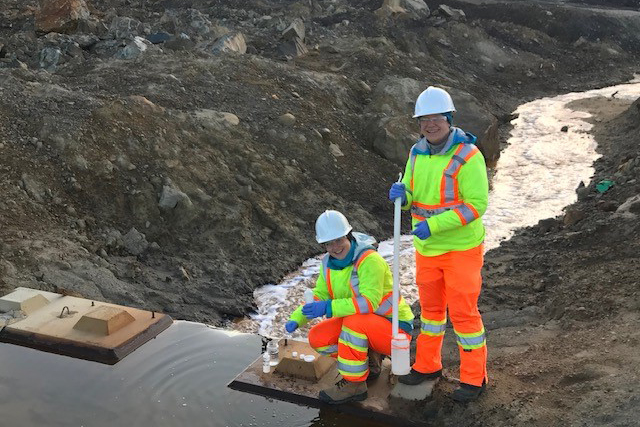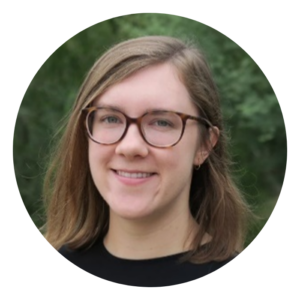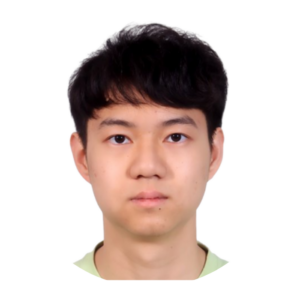
A mine straddling the border of Saskatchewan and northern Manitoba will be the first site in the world to deploy an innovative new technique for monitoring and managing sulfur compounds, including thiosalts.
The strategy improves understanding of possible impacts in the receiving environments, and has far-reaching applications for global mines processing sulfide containing ores.
“Not only does this new method improve our data collection and help us better understand and manage our environmental liabilities, it also simplifies Hudbay’s logistics and reduces analytical costs, given that this mine is located far away from commercial laboratories,” says Landice Yestrau, EP Superintendent, Environmental Compliance at Hudbay.
The global-first strategy has just received regulatory approval, and was co-developed by an international research team led by U of T Engineering Professor Lesley Warren (CivMin), including Dr. Simon Apte of Australia’s Commonwealth Scientific and Industrial Research Organization (CSIRO) and Canadian mining company Hudbay Minerals, Inc.
The details of the newly developed process are laid out in a paper published in June 2020 in Mine Water and Environment.
“Thanks to this world-first research, we are now able to measure the total possible sulfur risk with this new method. It’s clear that the previous industry standard ‘thiosalts’ methods under-report these risks in our effluent and receiving waters,” says Shirley Neault, Manager, Environment and Systems, Hudbay Minerals. “This is a major win for everyone.”
The technique is faster, cheaper and more accurate than the current industry standard methods. This innovative in-situ environmental management method is critical due to the mine site’s remote location.
Mitigating thiosalt impacts, which can cause toxicity, acidity and contamination in receiving environments if not properly managed, is a concern for mines around the world because the majority of metals come from sulfide minerals.
The Saskatchewan government’s recent approval further signals the critical need to capture and measure risks associated with the long-standing issue of sulfur compounds and bolsters the industry’s future water stewardship strategies.
“Now that mines can effectively track possible sulfur risks, the ability to proactively manage impacted waters is improved and environmental stewardship goals become actionable steps,” says Warren.
Hudbay’s 777 mine produces both zinc and copper, and is located near the town of Flin Flon, which sits on the border between Saskatchewan and Manitoba.
The new “reactive sulfur” method is one of many coming out of Mine Wastewater Solutions: Next Generation Biological Treatment through Functional Genomics.
This large-scale research project, led by Warren, is funded by Genome Canada, the Ontario Ministry of Research and Innovation, and industry partners including Hudbay, Glencore Sudbury INO (Integrated Nickel Organization), Rambler Metals and Mining, EcoReg Solutions Incorporated (ERSI) and Ecometrix – along with sector agencies Mining Association of Canada (MAC), Ontario Mining Association (OMA) and Mine Environment Neutral Drainage Program (MEND).
The multidisciplinary project applies functional metagenomics, geochemistry, biochemistry and modelling to mining wastewaters to develop innovative biological monitoring, management and treatment tools.
The collaboration illustrates the power of academia and the private sector, supported by governments, to develop research-powered solutions to address complex, multidisciplinary problems that transcend borders.
“Partnering with a global, multi-institutional team has allowed us to collaborate on research priorities and generate a wealth of new knowledge accelerating real outcomes at site,” says Neault. “These researchers offer tremendous expertise and together we are driving a range of biological treatments and innovations at our mines.”
By Rachel Wallace
The Mining Wastewater Solutions Project (MWS Project) is jointly funded by Genome Canada (LSARP program), Ontario Genomics, Genome Quebec, Ontario Government (MRI, ORF-RE program) and industry mining company partners (Glencore Sudbury INO, Hudbay Minerals and Rambler Metals and Mining). The international research team includes Dr. Lesley Warren (University of Toronto), Dr. Jill Banfield (Univeristy of Callifornia, Berkeley), Dr. Christian Baron (Université de Montréal) and Dr. Simon Apte (CSIRO). Industry partners also include Ecoreg Solutions and Ecometrix consulting companies, and MAC, OMA and MEND sector agencies.
Major renovation of CivMin’s Structural Testing Facility starts with the impressive one-day move of the Shell Element Tester
One of the biggest lab renovations in University of Toronto’s history is underway.
Last Friday, the Shell Element Tester (SET) was moved in preparation for further construction in the Structural Testing Facility that the Department of Civil and Mineral Engineering operates in the Galbraith and Sanford Fleming Buildings.
The first stage was a massive undertaking.
With snow coming down hard, a flatbed truck carrying a forklift rolled up to the loading dock just after 8 a.m.
The forklift was craned in and lowered onto the facility floor. Then, using a specialized team and equipment, the SET was raised off the floor, pulled back from its original position, rotated 180 degrees, and relocated 10 meters to the north wall of the facility.
Crews wrapped up work by late afternoon.
Department Chair Prof. Brent Sleep remarks on the significance of this stage of the process.
“After many months of planning, it is exciting to see this first step in the development of our scale multi-dimensional testing facility. This state-of-the art facility will help our professors, students, and industry partners address some of the most challenging problems in structural resilience under extreme conditions. ”
The SET is a one-of-a-kind 60-tonne steel frame with 40 hydraulic actuators.
This is the second time the machine has moved since it was commissioned. The last time was following a 2008 renovation.
Read more on the Structural Testing Facility renovations happening in 2022
By David Goldberg
February 28, 2022 | OHS Canada Magazine
February 25, 2022 | CBC – The Current (1:01:20)
As part of its mission, the School of Cities (SofC) Graduate Student Fellowship Award provides a forum for urban-focused interdisciplinary and collaborative learning.
SofC Graduate Student Fellows are current U of T students with a strong interest in and passion for urban issues and critical challenges and are leading an innovative and impactful project this term. Two of the 20 selected are from the Department of Civil & Mineral Engineering (CivMin).
Meet our 2022 Fellows from CivMin:
 Emily Farrar
Emily Farrar
Emily is a second-year PhD student in CivMin. Her research interests revolve around the intersection of climate change mitigation, the transport sector, and public health. She is excited to investigate strategies to reduce public exposure to air pollutants from traffic sources. Prior to entering the PhD program, Emily worked on topics such as shared mobility and emerging technologies at UC Berkeley’s Transportation Sustainability Research Center. She is currently a volunteer with the University of Toronto’s Graduate Society of Women Engineers, where she serves as the VP of Communications.
 Yunshun Zhong
Yunshun Zhong
Yunshun is a first-year PhD student in Civil Engineering. He has a M.S. degree in Civil Engineering and minor in Data Science from University of California, Berkeley. His research interests lie in the application of machine learning and artificial intelligence in infrastructure asset management. In particular, he is trying to develop an automated shoreline erosion detection and monitoring system based on aerial images by unmanned aerial vehicles using machine learning algorithms. Cities with long shoreline such as Toronto is highly vulnerable to natural hazards of flooding and erosion of shoreline. Therefore, identification and remediation of shoreline hazards is a significant task in urban development and urban environment protection, in which, shoreline erosion monitoring plays a fundamental role.
This article originally published by School of Cities – see the entire list of recipients
Jan/Feb 2022 | ASTM International – Standardization News
February 22, 2022 | National Post
February 20, 2022 | The Conversation
February 21, 2022 | YGK News
Sarah Haines is an Assistant Professor who just started teaching with CivMin in January. Before joining U of T, she completed her undergrad, masters and PhD at Ohio State University. We recently connected with her to learn more about her research and why she’s so passionate about what she does.
How do you like teaching at U of T so far?
It’s been great! I’ve really been enjoying interacting with the students, so it’s been great. We started off on Zoom, but now we’re back in person, so it’s great to see people’s faces—even behind a mask.
What’s your research specialty?
My research specialty is indoor air quality and the indoor microbiome(s). I focus on the microbiology aspect of building science and how that impacts human health. Specifically think about mold growth in homes and how mold and moisture can impact upper respiratory systems. Ultimately, I’m working to make those broader connections between air quality and health outcomes in indoor environments.
I’m hoping to establish new techniques and technologies to prevent mold growth in homes and provide ways to make sure that we have new, sustainable materials or that we’re using different methods to prevent these harmful exposures indoors.
One of the interesting tools that I’ve leveraged has been using smartphones as a method to detect different exposures in housing. Theoretically, we could all use an app on our phones to determine exposure or concentrations of microbes or maybe even CO2 concentrations in our homes.
What kind of future research projects are you looking into?
I’m really passionate solving issues in sustainable housing. Often, we see lots of mold growth and moisture issue in these Indigenous communities and it’s truly a systemic problem. I’m really hoping to be working directly with these communities to establish solutions for these potential harmful exposures.
Is there something that pushed you in this direction that you’ve taken with your research and your career?
My grandmother had some upper respiratory issues and it got me thinking about what she might have been exposed to growing up. This got me thinking about the situation in housing communities at socio-economic disadvantage. Now I want to know how we can improve indoor air quality and just housing quality in general.
What’s the coolest project you ever go to be part of?
Analyzing space dust! While doing my masters and PhD research, we were in connection with someone at NASA who wanted to send us some “space dust”. I will admit, initially we were so excited thinking it was going to be from Mars or the moon, but it turned out to be just some dust they vacuumed up at the International Space Station. It was still very cool, but a bit of a letdown! We tested it for different micro biological components of bacteria and fungus, as well as particle size, and provided the results to them.
You grew up and did all your schooling in Ohio before moving to Toronto, correct?
Yes, I grew up in Kirtland, Ohio, a suburb of Cleveland. What I really loved about growing up there, is that we were close to a city, but I was also close to different farms and rural life. I grew up in a very small town where everyone knew everyone and we went to football games on Friday nights. I was even in the marching band.
You play the flute, right?
I started playing in middle school and I was part of the Cleveland Youth Wind Symphony in high school, and I still play today.
What’s your go-to song?
I have the sheet music from the ‘Pride and Prejudice’ movie with Keira Knightley. I really enjoy playing songs from that.
By David Goldberg